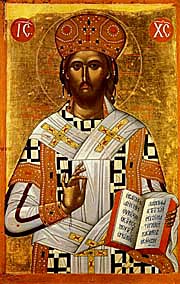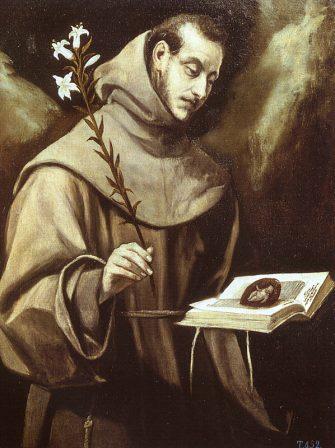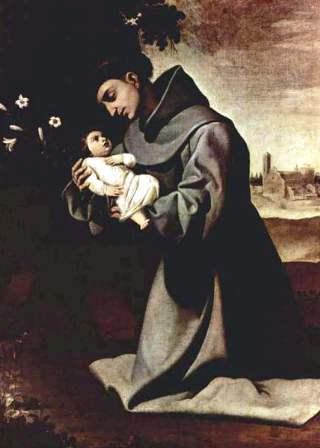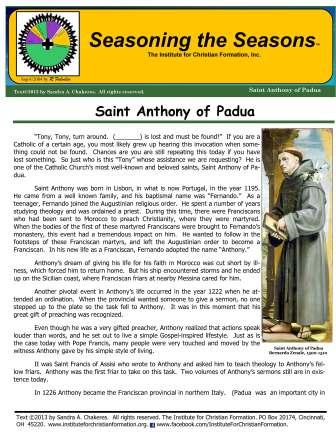The Institute for Christian Formation

Saint Anthony of Padua, Priest & Doctor of the Church
Feast Day (Memorial): June 13
“Tony, Tony, turn around. (_______) is lost and must be found!” If you are a Catholic of a certain age, you most likely grew up hearing this invocation when something could not be found. Chances are you are still repeating this today if you have lost something. So just who is this “Tony” whose assistance we are requesting? He is one of the Catholic Church’s most well-known and beloved saints, Saint Anthony of Padua.
Saint Anthony was born in Lisbon, in what is now Portugal, in the year 1195. He came from a well known family, and his baptismal name was “Fernando.” As a teenager, Fernando joined the Augustinian religious order. He spent a number of years studying theology and was ordained a priest. During this time, there were Franciscans who had been sent to Morocco to preach Christianity, where they
Saint Anthony of Padua
El Greco, 1580
were martyred. When the bodies of the first of these martyred Franciscans were brought to Fernando’s monastery, this event had a tremendous impact on him. He wanted to follow in the footsteps of these Franciscan martyrs, and left the Augustinian order to become a Franciscan. In his new life as a Franciscan, Fernando adopted the name “Anthony.”
Anthony’s dream of giving his life for his faith in Morocco was cut short by illness, which forced him to return home. But his ship encountered storms and he ended up on the Sicilian coast, where Franciscan friars at Messina cared for him.
Another pivotal event in Anthony’s life occurred in the year 1222 when he attended an ordination. When the provincial wanted someone to give a sermon, no one stepped up to the plate so the task fell to Anthony. It was in this moment that his great gift of preaching was recognized.
The Christ Child and
Saint Anthony of Padua
Francisco de Zurbarán, circa 1640
Oil on canvas
Museo del Prado, Madrid, Spain
Even though he was a very gifted preacher, Anthony realized that actions speak louder than words, and he set out to live a simple Gospel-inspired lifestyle. Just as is the case today with Pope Francis, many people were very touched and moved by the witness Anthony gave by his simple style of living.
It was Saint Francis of Assisi who wrote to Anthony and asked him to teach theology to Anthony’s fellow friars. Anthony was the first friar to take on this task. Two volumes of Anthony’s sermons still are in existence today.
In 1226 Anthony became the Franciscan provincial in northern Italy. (Padua was an important city in northern Italy.) Not too long after this, when he was thirty-three years old, Anthony had the occasion to meet Pope Gregory IX in Rome.
Anthony was invited to preach, and once again the response to his gift of preaching was phenomenal – some even said it was an event like Pentecost!
Anthony once again became ill, and requested to step down as provincial. He continued to preach, though, and the crowds that came to hear him in Padua were massive. The effort expended in his preaching took its toll on Anthony, so he went to a nearby town to rest. But he soon realized that death was imminent, and he wanted to return to Padua. He never quite made it there. Anthony died in 1231 at the age of thirty-six years. After his death, so many miracles took place at Anthony’s tomb, that the following year (1232) Pope Gregory IX declared Anthony a saint. In 1946 Pope Pius XII declared Anthony a Doctor of the Universal Church. He is known as the “Evangelical Doctor.”
Saint Anthony of Padua is the patron saint of Portugal, the poor, and lost items. We began this reflection on Saint Anthony noting how he is invoked when something is lost. Find out more about this tradition in this short video by the Apostleship of Prayer.
In Portugal, many weddings take place on the June 13 feast of Saint Anthony, and the brides are called “Saint Anthony’s brides.” Grilled sardines are plentiful on the streets of Portugal this day, as well. This goes back to a story that says once when Saint Anthony was upset that some people did not listen to his sermon, he went to preach to the fish! Basil and sangria are also popular on Saint Anthony’s feast day, as is “Saint Anthony’s bread.” There is a tradition that some people, when their prayers of intercession to Saint Anthony are answered, make a donation to the poor. This might be a monetary donation, but sometimes individuals and even parish communities bake small loaves of bread in honor of Saint Anthony which they then distribute to the poor and hungry. You can find out yet more about Saint Anthony’s bread and get recipes for bread and sangria here.
In art, Saint Anthony of Padua is often depicted with a lily (a symbol of purity); a book due to his education and teaching; and/or the child Jesus (it is said that Saint Anthony once had a vision of the child Jesus). Monastery Icons is one source for Saint Anthony icons and holy cards.
Learn more about Saint Anthony from the transcript of Pope Benedict XVI’s General Audience on February 10, 2010. A good book about Saint Anthony is “Saint Anthony of Padua: His Life, Legends, and Devotions”, edited by Jack Wintz, O.F.M.
You can take a virtual tour of the Basilica of Saint Anthony in Padua here. Here is a source for a Litany of Saint Anthony of Padua.
Salt and Light TV has a documentary, “Finding Saint Anthony: A Story of Loss and Light.” Learn more from the trailer below.
Follow us on Facebook to keep up to date with our news and newest resources!


Click on the image above to download our ICF handout on Saint Anthony of Padua.
Celebrate Saint Anthony’s feast day in your home or parish. Share some stories from his life, read the Bible, bake some bread (and share some with the poor!), put lilies on your table, enjoy grilled sardines and basil, and raise a glass of sangria in a toast to Saint Anthony of Padua!
